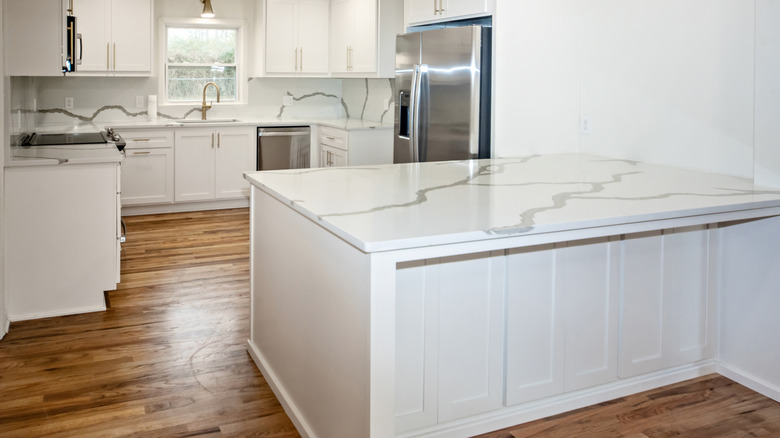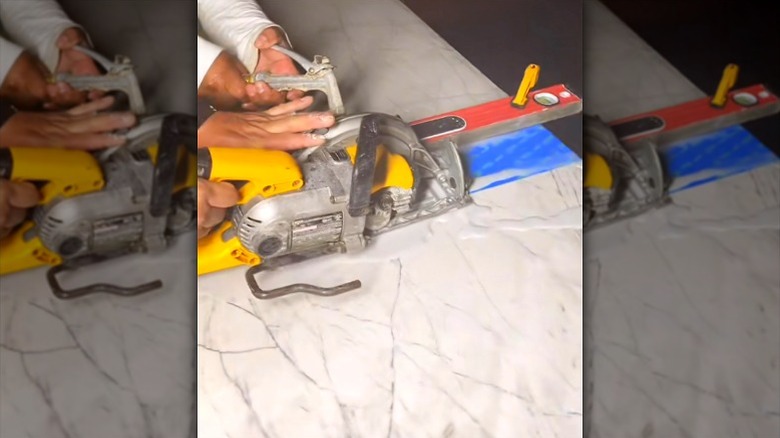How To Cut Quartz Countertop With A Common Saw
We may receive a commission on purchases made from links.
Quartz is a gemstone that can capture a variety of colors and patterns, which has made it one of humanity's most-used stone materials since the days of the ancient Greeks. Unlike many common types of stone countertops, such as granite and marble, quartz often doesn't need to be sealed or polished, making it easier to maintain and clean up any messes in your kitchen or bathroom. Engineered quartz countertops are even considered more durable and less likely to stain or develop bacterial cultures. However, stone countertops can be pricey to install, which means it may be worth looking into ways you can cut and put in your own quartz countertop using common home workshop tools, like circular saws.
Going for a slim profile is probably the best thickness for quartz countertops on a budget, as a 1- or 2-centimeter thickness will save you substantial money and be easier to cut. Even an inexpensive option, like the Skil 7 ¼-Inch Circular Saw, can hold a diamond-tipped saw blade (e.g., DEWALT Diamond Blade) that's more than capable of cutting through stone. A DIY quartz countertop can be measured and cut with just a few additional materials, including lumber for support, some clamps, and a pen to mark out your lines.
Safely cutting quartz countertops with a circular saw
Right off the bat, there's one easy mistake you'll want to avoid before installing new countertops: not measuring. Be extra careful to measure out how much material you need for the space. Once you know your countertop's size, lay masking tape over the raw material and draw cut lines on it; this will let you move the line if you made a measuring mistake and avoid accidentally marking up the quartz. When you get to the cut, it's best to lay the countertop over a parallel series of at least four sawhorses or similar supports and clamp it in place so that neither side will fall away. Clamp a level or other straight edge guide to the quartz to keep the saw blade straight as it moves along the cut line.
With your quartz clamped down and guiding lines taped, rev your circular saw to full speed before cutting, keeping the saw aligned on the waste side being cut away. Move your blade at a steady, slow pace. If you notice it binding or smoking during the cut, rest the blade for a couple of minutes. A quartz countertop does not need to be sealed, so after cutting, grind down any rough edges left by the blade before installing. However, it is worth keeping in mind that engineered quartz can be upwards of 90% silica — overexposure to the dust can increase the risk of silicosis, lung cancer, and other negative health outcomes. It's important to wear appropriate eyewear, earplugs, and dust masks. Also, be sure to avoid loose-fitting clothes or gloves that might get caught in mechanical parts.
Try cutting your quartz countertop using water
If you're concerned about health issues that may arise from cutting your countertop at home, coating the surface of your quartz countertop in water is the ideal way to approach this project, as doing so will provide lubrication, trap dust, wash away debris, and ensure the material isn't damaged by overheating. Going with a full pressurized waterjet cutting is probably out of your home DIY budget, but you can try augmenting your dry saw blade cut by running a hose at low pressure in front of the blade. Alternatively, there are saws you can buy with integrated water delivery systems. Just make sure to clean up the slurry left by that combined water and silica dust with a wet vacuum; otherwise, it will release the dust anyway upon drying.
Regardless of how you cut your quartz countertop, you should consider buying tools to help with extra ventilation, such as portable exhaust fans, when working in closed-in areas. Incorporating water for a home DIY job can also be dangerous if you aren't taking additional measures like plugging your saw into a GFCI outlet to prevent electrical shorts. If you can't minimize the risk, you may want to just have it professionally cut. A countertop installation will have case-by-case questions that might be best answered with an expert's consultation for your particular home, but it's important to remember there are things you should never do with a quartz countertop, like leaving hot pans on the surface or scrubbing with an abrasive sponge, as this can cause permanent damage.

